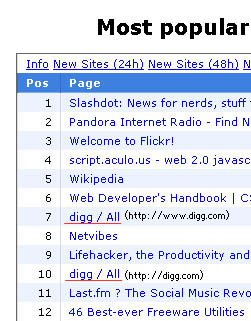WWW or no-WWW?
Whenever you create a website or a blog it usually can be accessed either through “http://www.domain.com” or “http://domain.com”. While this feature might appear useful at a first sight (since people can type whatever version they prefer) over the long run it will harm your search engine ranking.
The problem arises because Google and other search engines view the two versions as two distinct sites, even if they have the exact same content (technically, in fact, the “www” denotes a subdomain that could point to different content).
Search engine ranking is based, among other things, on the number of incoming links to your site. If you keep the two versions available some people will link to “http://www.domain.com” while other people will link to the “http://domain.com”, basically splitting your backlink count.
 Having two different versions might damage you in popular lists and social bookmarking sites as well. The picture on the right was extracted from Populicious, a site that lists the most popular sites on Delicious. If you take a look you will notice that Digg is listed both at the 7th and 10th position. This happens because the list treats “http://www.digg.com” and “http://digg.com” as two different sites. Shoud only one version be available the combined number would place Digg on the first position of the list.
Having two different versions might damage you in popular lists and social bookmarking sites as well. The picture on the right was extracted from Populicious, a site that lists the most popular sites on Delicious. If you take a look you will notice that Digg is listed both at the 7th and 10th position. This happens because the list treats “http://www.digg.com” and “http://digg.com” as two different sites. Shoud only one version be available the combined number would place Digg on the first position of the list.
How do you solve the problem for your blog? The easiest way is to set up a “301 Permanent Redirect” from the “no-www” version to the one with “www”, or vice-versa. Once the redirect is in place every time a visitor types http://domain.com he will automatically be redirected to the “www” version.
By the way, if you are wondering whether you should go with or without “www”, it does not matter. The important thing is that you pick one and stick with it.
Update: Check out the article “How to setup a 301 Redirect“
